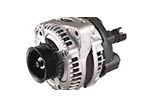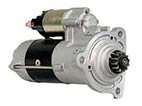Spares

Gear
A gear or cogwheel is a rotating machine part having cut teeth, or cogs, which mesh with another toothed part to transmit torque. Geared devices can change the speed, torque, and direction of a power source. Gears almost always produce a change in torque, creating a mechanical advantage, through their gear ratio, and thus may be considered a simple machine. The teeth on the two meshing gears all have the same shape. Two or more meshing gears, working in a sequence, are called a gear train or a transmission. A gear can mesh with a linear toothed part, called a rack, thereby producing translation instead of rotation.The gears in a transmission are analogous to the wheels in a crossed, belt pulley system. An advantage of gears is that the teeth of a gear prevent slippage.

Charging Alternator
The alternator is the heart of the charging system. It generates all the power needed to keep the battery fully charged and to operate everything electrical in the vehicle. The alternator is mounted on the engine and is belt-driven off the crankshaft pulley by a serpentine belt or v-belt. The alternator produces alternating current (AC), which is converted to direct current (DC) by a six diode rectifier, which is usually located inside the back of the unit. Diodes only pass current in one direction, which is how they convert AC current to DC. Three positive diodes control the positive side of the AC sine wave, while three negative diodes control the negative side.

Piston
A piston is a component of reciprocating engines, reciprocating pumps, gas compressors and pneumatic cylinders, among other similar mechanisms. It is the moving component that is contained by a cylinder and is made gas-tight by piston rings. In an engine, its purpose is to transfer force from expanding gas in the cylinder to the crankshaft via a piston rod and/or connecting rod. In a pump, the function is reversed and force is transferred from the crankshaft to the piston for the purpose of compressing or ejecting the fluid in the cylinder. In some engines, the piston also acts as a valve by covering and uncovering ports in the cylinder wall

Starting Motor
A starter (also self starter, self, or starter motor) is an electric, pneumatic, hydraulic, an internal-combustion engine in case of very large engines or other device used for rotating an internal-combustion engine so as to initiate the engine's operation under its own power.Internal-combustion engines are feedback systems, which, once started, rely on the inertia from each cycle to initiate the next cycle. In a four-stroke engine, the third stroke releases energy from the fuel, powering the fourth (exhaust) stroke and also the first two (intake, compression) strokes of the next cycle, as well as powering the engine's external load. To start the first cycle at the beginning of any particular session, the first two strokes must be powered in some other way than from the engine itself.